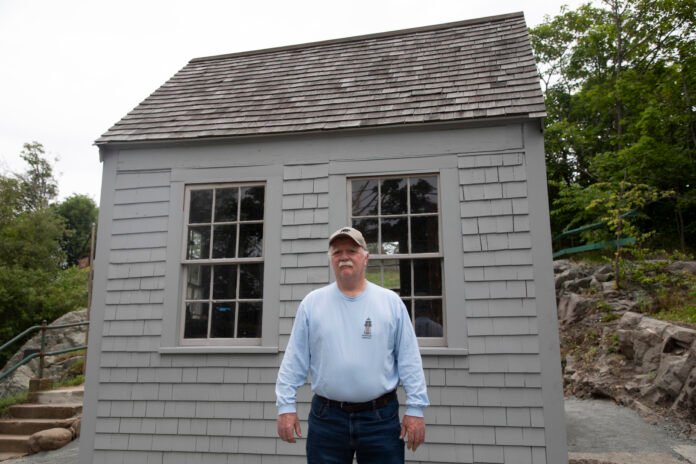A small, overlooked old shed sitting on Orne Street for nearly two centuries is now becoming a little museum, giving Marbleheaders a glimpse of a forgotten part of Marblehead history. The 175-year-old building, called a “ten-footer” because of its 10 by 10 dimensions, was once one of dozens of shoe production workshops in 19th-century Marblehead. It is now one of the last remaining sheds in town, and has remained unused and deteriorating for decades. But now the Marblehead Historical Commission has been restoring it to provide Marbleheaders with a window into their town’s rich past.

The ten-footers have always been an underappreciated part of Marblehead’s history, and played an important role in the town’s economy during the 18th and 19th centuries. They allowed fishermen and their families to supplement their income after the fishing season ended.
“They were outbuildings that people built in their backyards. They were built specifically for shoemaking,” explained Pam Peterson, the chair of the Historical Commission. “Most people that had them were fishermen for most of the year. There was a long tradition, even in colonial times, that the fisherman and their wives and children made shoes in the winter to make some extra money. This one dates from about 1850.”
Shoe sheds like these were commonplace in Essex County during this time period, when shoemaking was a major industry. The shoemaking industry became a major part of Marblehead’s economy after the Gale of 1846 devastated the town’s fishing fleet. After the Gale, which took the lives of 75 Marbleheaders and sank 11 vessels, the fishing industry declined, and the town started to rely heavily on shoe making. From the 1860s, until 1900, there were over 60 shoe making factories in Marblehead.

The Historical Commission has spent the last eight years slowly refurbishing the 10-footer. The 2020 Covid pandemic slowed down the process, but significant progress has been made since.
“The building has been restored, the shingles have been replaced, the roof has been repaired, and a handicapped accessible path has been made,” said Peterson. “Next we will do some signage and displays of shoemaking tools and shoes.” The funds for the refurbishment of the shoe shed are being provided by the Harold B. and Elizabeth L. Shattuck Fund.
Historical Commission member Chris Butler has been working to restore the workshop to its former glory, and he has had a major impact on the project.
“I put a window in, put some siding on, and painted the place,” said Butler. “Now we’re going to do some more work to set up a little museum inside.”
Butler first encountered the shoe shed in 2016, when he inspected the building for the Town of Marblehead. Despite how much the structure had deteriorated, Butler saw promise in its historical significance.
“I reported that it’s probably a one out of 10 structurally, but it’s an 11 out of 10 historically. And at that point they gave it to the historical commission,” recalled Butler.
After retiring just a few years later, Butler decided to use his skills to help restore the shoe shed so others could enjoy it and learn more about Marblehead history.
“I worked in construction for 38 years, and my passion has always been in building,” said Butler. “I have the skills, so I thought why not create this little monument to Marblehead’s history.”
Though the project may draw relatively few visitors and be off the beaten tourist path, Peterson believes that it is an important one nevertheless.
“The historical commission tries to preserve the history of the town, and this is certainly an aspect of Marblehead’s history that was very important,” said Peterson. “It sustained the fishermen and their families, and it’s also an important part of the history of Essex County, and New England in general.”






